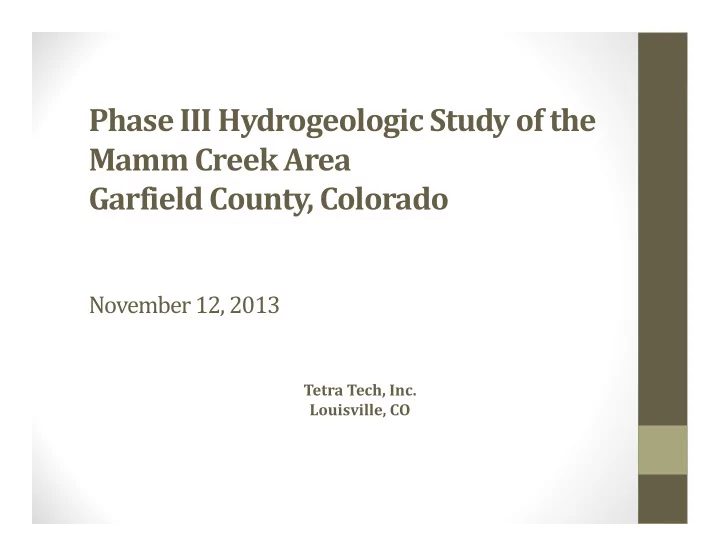

Phase III Hydrogeologic Study of the Mamm Creek Area Garfield County, Colorado November 12, 2013 Tetra Tech, Inc. Louisville, CO
Project History • Phase I Hydrogeologic Study (URS, 2006) • Broad review of historical data • Phase II Hydrogeologic Study (S.S. Papadopulos & Assoc., 2008) • Sample collection and data evaluation
Project Objectives • Gather additional data through installation of nested monitoring wells • Clarify the nature of the hydrologic flow system and water quality in the study area • Evaluate the possible effects, if any, of oil and gas development on the Wasatch Formation water quality
Monitoring Wells • Coordinated with Garfield County to locate three sets of nested wells • Local water wells are generally 200 feet deep or less • Wells installed during 2010 in Atwell Gulch member of Wasatch Formation • Well Screens (bgs): • A: 390 ‐ 405 feet • B: 590 ‐ 605 feet
MW ‐ 2A/B Currie Well MW ‐ 1A/B MW ‐ 3A/B
Monitoring Wells in Geologic Context Basemap from URS Phase I Study Report
Natural Gas Wells in Vicinity of Monitoring Wells
Water‐Level Measurements • Slow rates of recharge indicate tight matrix • Rapid water ‐ level rise after spring indicates fracture contributions • Stable lower water levels indicate deeper potentiometric equilibrium
Water‐Level Elevations
Vertical Hydraulic Gradients
Water‐Quality Sampling • Four sampling events: • January 2011 • May 2011 • August 2012 • December 2012
Chloride Distribution
Chloride Time‐Series Data
Methane Distribution
Methane Time‐Series Data
December 2012 Methane Isotopes
December 2012 Wet‐Gas Analysis MW ‐ 2B (May 2011) Bernard Diagram (after Whiticar, 1990)
Elevated Methane in MW‐2A • Methane concentrations in MW ‐ 2A: • 66 – 140 mg/L • Isotopes consistently indicate biogenic source • As observed in Currie Well with similar isotopic signature, indications of carbonate ‐ reduction environment: • Reducing groundwater chemistry • Oxidation ‐ reduction chemistry measured during sampling • “Rotten ‐ Egg” odor observed during sampling at MW ‐ 2A and Currie Well
Elevated Methane in MW‐2A • Likely source of methane in subsurface is carbon dioxide being reduced via microbial processes to methane CO 2 + 4H 2 = CH 4 + 2H 2 O • Carbon dioxide origin is unknown, may be naturally occurring in Wasatch Formation
Benzene Concentrations • Not detected conclusively in MW ‐ 1A, MW ‐ 2A, MW ‐ 3A • MW ‐ 1B concentrations ranged from ND to 5.3 ug/L • MW ‐ 2B concentrations ranged from 1.4 to 3.4 ug/L • MW ‐ 3B concentrations ranged from ND to 1.5 ug/L • Currie Well concentrations ranged from 1.3 to 1.8 ug/L • Benzene concentrations greater with depth
Summary of Groundwater Flow Interpretation • Bedrock is combination of low ‐ permeability siltstones and sandstones • Significant fractures exist, probably associated with structural anticline feature • Water flows within this “dual ‐ porosity” geology • Water levels in wells may vary seasonally due to infiltration of snowmelt or rain into fracture network
Summary of Water Quality Interpretation • Chloride is locally elevated in concentration • Consistent with concentrations in domestic wells near Phase III study • In general, concentrations appear to increase with depth • Exception is MW ‐ 2 well nest • TDS, pH, alkalinity not useful in water quality interpretation • Grout ‐ fluid intrusion into adjacent fractures • Piper diagrams used for evaluation of other wells not appropriate evaluation tool because of high alkalinity
Summary of Water Quality Interpretation, cont. • Benzene present in low concentrations (ND to 5.3 µg/L) • Consistency of detected concentrations suggests benzene is not derived from localized source, but likely naturally occurring within Wasatch Formation • Methane in shallow wells possesses biogenic signature different from that of Williams Fork Formation • Methane in deep wells possesses thermogenic signature
Summary of Water Quality Interpretation, cont. • Higher concentrations of methane in initial samples at certain wells • After multiple rounds of development and sampling, methane concentrations are more consistent from well to well • Suggests that methane is typically present in groundwater • Methane concentrations do not specifically point to gas production source, instead likely naturally occurring • Higher concentration and biogenic at surface • Lower concentration and thermogenic signature in deeper interval • Methane may be moving to wells through fractures, or trapped in intercepted isolated pockets in the Wasatch Formation
Conclusion • The Phase III Study provided a understanding of groundwater chemistry in the hydrogeologic layers located about 200 feet deeper than those typically utilized for domestic purposes • The Phase III Study did not show clear evidence of oil and gas impacts on Wasatch Formation water quality
Recommend
More recommend